- The Bottom Line, Up Front:
- How I Judge The Best Systems
- The Best Payroll Systems for Hourly Teams
- 1) Homebase: The All-in-One for the Hourly Team
- 2) Gusto: Easy Payroll with HR Basics
- 3) Square Payroll — POS-Native for Retail and Restaurants
- 4) ADP RUN: Scalable With Classic Payroll Depth
- 5) Paychex Flex: Flexible Bundles with Strong Time Tools
- 6) QuickBooks Payroll + QuickBooks Time: Best When Your Books Already Live in QuickBooks
- How I Would Choose (Real World Scenarios I’ve Been Through)
- Implementation Checklist That I Walk Through With Clients
- Where Each Platform Wins
- Final Thoughts
Last Updated on November 5, 2025 by Ewen Finser
If you’re reading this, you’re probably trying to get away from your current payroll provider and into one that actually works. As a CPA who has set up and run payroll for hourly teams for years, let me tell you, there are systems out there that work, and systems that will never quite do what you want them to.
I’ve used both, and let me tell you, the best thing you can do is separate from those systems and cut your losses. When hourly work is your core, the little things, like shift swaps, break rules, missed punches, and split roles, matter more than glossy dashboards. Below is how I think about the six platforms most owners ask me about.
The Bottom Line, Up Front:
If you run restaurants, retail, job-site crews, or any team that lives by the schedule, put Homebase at the top of your shortlist. It combines time clocks, scheduling, messaging, and payroll in one place, and it adds tip tools many hourly shops need.
That said, Gusto, Square Payroll, ADP RUN, Paychex Flex, and QuickBooks Payroll + QuickBooks Time are all strong picks for the right use case. Choose based on how your hours move from the time clock to the pay run, how you handle tips, and what you need for compliance.
How I Judge The Best Systems
Here’s some of the criteria I look for when evaluating a platform:
- Time to payroll: Can I convert approved hours to wages without retyping anything?
- Scheduling and time clocks: Built-in or add-on? Kiosk support? GPS if crews are mobile?
- Overtime and breaks: Can I enforce rules and spot exceptions before payroll?
- Tip handling: How are tip pooling/splitting, cash-tip tracking, and reporting for taxes integrated into the systems?
- Job costing and labor controls: Can I tag jobs/projects, compare planned vs actual, and curb overtime?
- Mobile experience: Do frontline managers and employees actually use the app?
- Integrations: POS for restaurants/retail, accounting, and benefits.
- Pricing clarity: What’s all this going to cost my client?
With that lens, here’s how the big names stack up.
The Best Payroll Systems for Hourly Teams
1) Homebase: The All-in-One for the Hourly Team
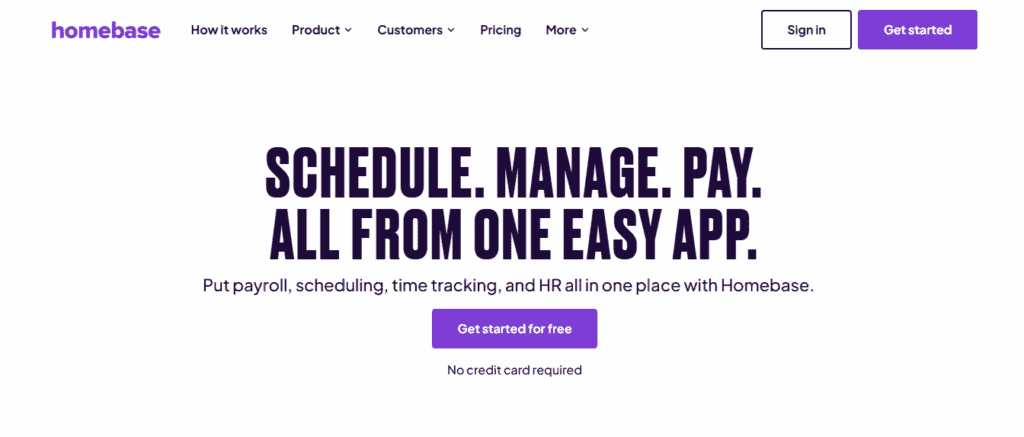
Why I Like It
Homebase is built for hourly workplaces. Scheduling, time clocks, messaging, and payroll sit in the same app. That means approved timesheets flow straight into payroll with fewer mistakes. Homebase also offers a Tip Manager module that pulls tips from the POS and calculates pools, then sends those amounts into timesheets. For a restaurant, bar, or café, that saves a lot of end-of-shift math.
In day-to-day use, what makes Homebase stand out for me is how seamlessly everything connects. Once schedules and hours are approved, payroll updates automatically—no spreadsheets, imports, or double entry. Breaks, overtime, and tips are calculated natively, and the system flags potential compliance or tax errors before they become real issues. Setup is quick, support is human, and once it’s running, payroll simply happens in the background with reliable accuracy. It’s a low-maintenance loop that keeps hourly teams moving.
Pricing
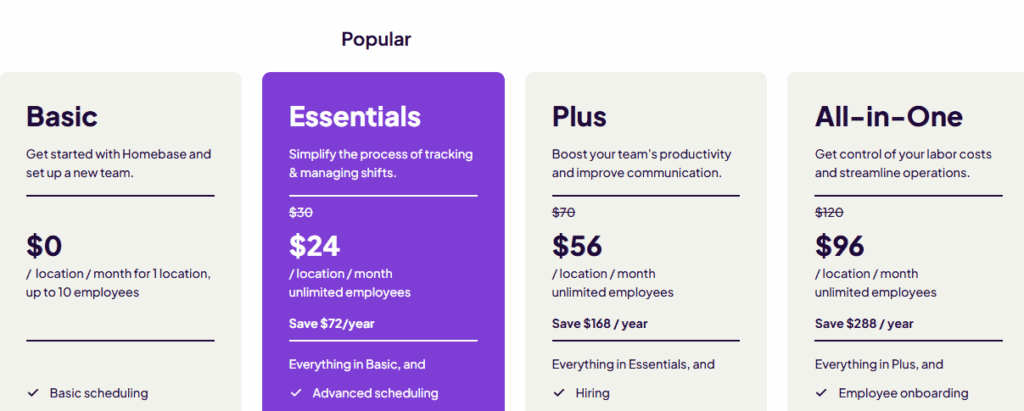
Homebase Payroll is an add-on. As of the time of this publication, Homebase lists a $39/month base + $6 per employee paid, with a higher-tier “Next Day Pay” option at $49/month + $9/employee. Tip Manager is $25/month per location. Pricing pages change, so always confirm current rates.
Why It’s a Great Fit for Hourly Teams In My Opinion
- One login for scheduling, time, messaging, and payroll makes people want to actually use the platform.
- You have the option of kiosk time clocks, mobile time tracking, shift swaps, and PTO; alerts for overtime, all under one roof.
- Tip pooling tools plus cash-tip tracking for accurate tax handling reduce the use for manual spreadsheets.
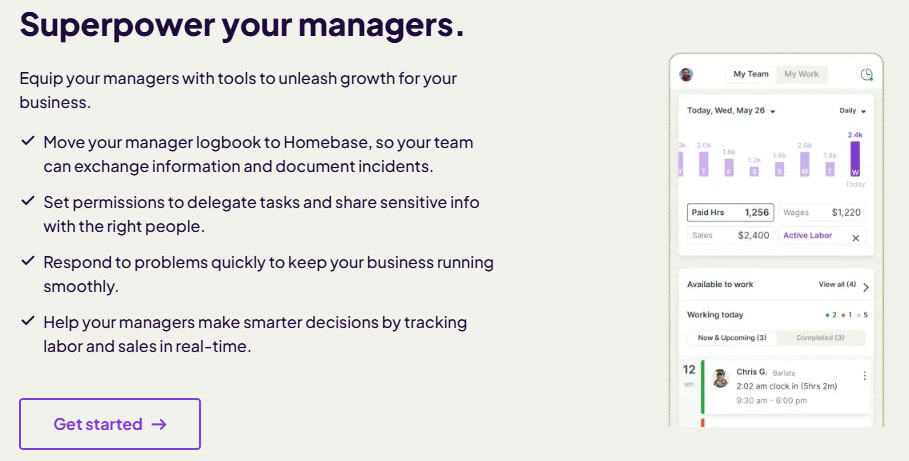
Trade-Offs
- Advanced enterprise HR and deep custom reporting are not the focus, and I feel that’s okay for most of my SMB clients
- Multi-entity setups with different EINs need care; Homebase payroll notes the same EIN and pay schedule across locations, so you need to pay attention to prevent confusing mistakes later.
Bottom line from my desk: For an hourly shop, fewer systems means fewer errors. Homebase gives managers one place to approve hours, control labor, handle tips, and run payroll.
2) Gusto: Easy Payroll with HR Basics
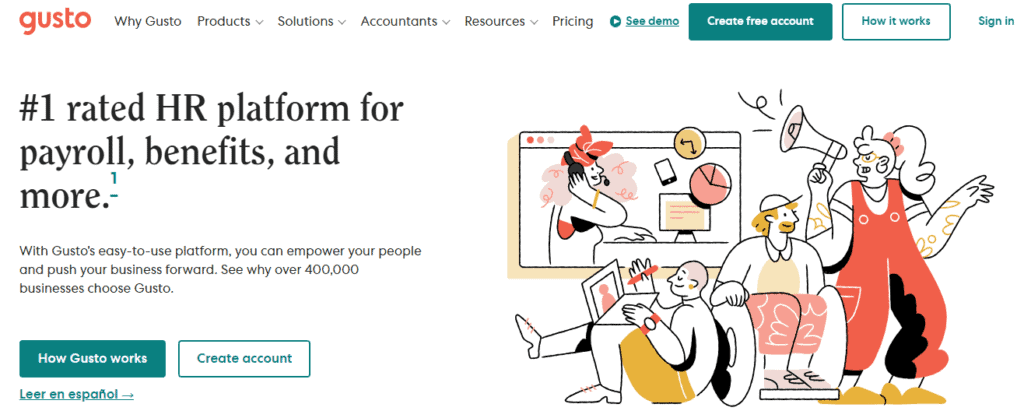
Why I Like It
Gusto’s strength is simple, reliable payroll with solid HR and benefits admin. It now includes native time tracking (Time Kiosk, job codes) on certain plans, which helps for hourly staff. On the Simple plan, you can add time tracking for a fee. The UI makes onboarding and payroll runs smooth, and compliance is so seamless that it’s almost second nature.
Pricing

Currently, the Simple plan is priced at $49/month + $6 per employee; Plus and Premium cost more but include time tools ($80 and $180 monthly). Gusto’s public pricing evolves and often runs promos, so check the live pricing page before you budget.
Fit for Hourly Teams
- I like that you can have multiple, different pay rates for the same employee depending on the job that they’re doing.
- Built-in time tools on upper tiers; integrates with third-party time apps if needed.
- Strong onboarding and employee self-service.
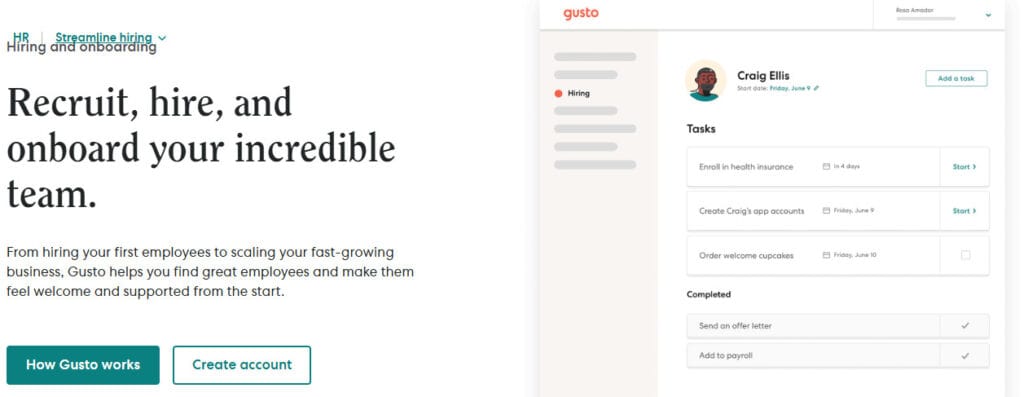
Trade-Offs
- On Simple, you pay extra for time tracking; no built-in scheduling, so to me you almost need to start at the mid-tier plan to have anything worthwhile, which is currently $80 a month.
- As headcount grows, per-person fees add up (this is true for all platforms, though).
My take: If you want a friendly payroll engine and light HR, and your scheduling needs are basic or handled elsewhere, Gusto is an easy yes.
3) Square Payroll — POS-Native for Retail and Restaurants
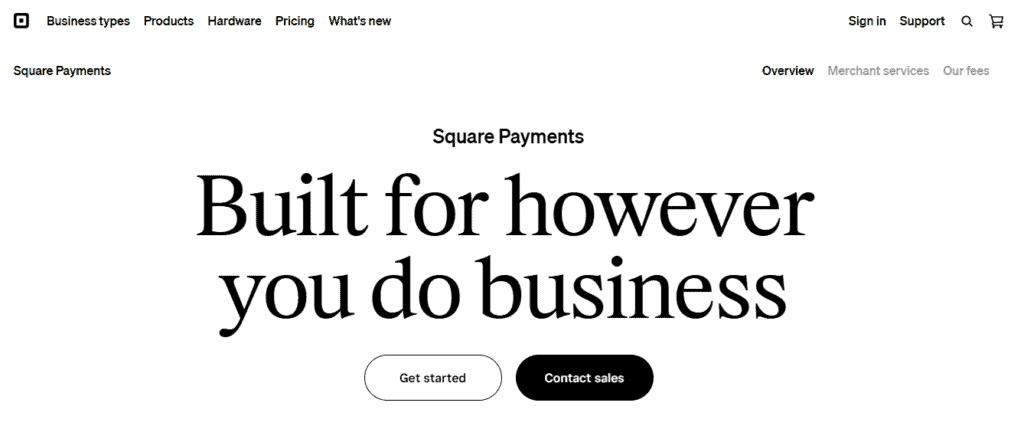
Why I Like It
Square is a juggernaut in the retail and food space, so it makes sense to consider their payroll options. If you already use Square POS, Square Payroll is the next natural fit. Timecards and sales live in the same ecosystem. Square Shifts adds scheduling, time tracking, tip pooling, and cash-tip tracking. Hours move to payroll with fewer handoffs, which helps when managers live on the POS all day. It also unlocks a ton of new reports when you have real data from all facets of the business in one place.
Pricing
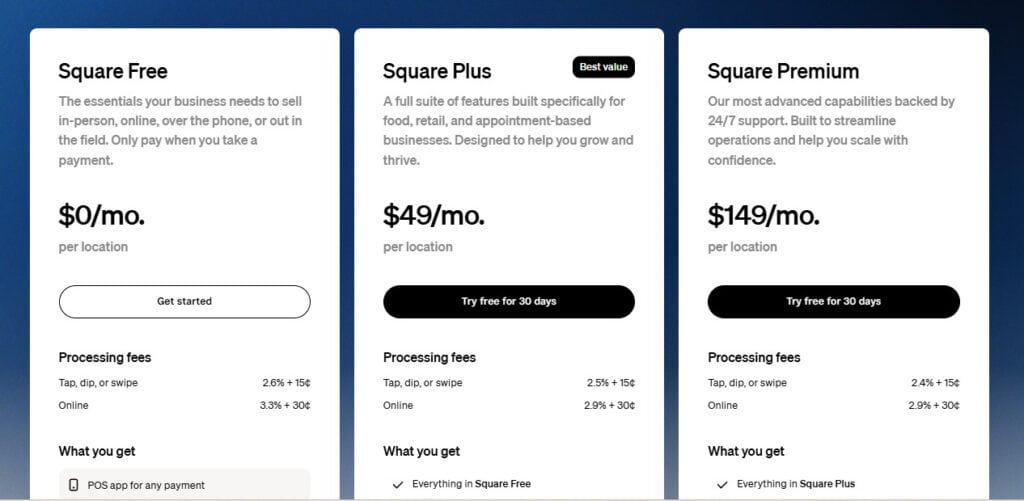
Square currently lists $35/month base + $6 per person paid for full-service payroll. Contractor-only payroll is $6 per person paid.
Fit For Hourly Teams
- Tight link between POS, timecards, tips, and payroll.
- Tip pooling options and cash-tip tracking reduce manual work, although I haven’t been super impressed with this feature and have often found myself resorting to a spreadsheet to get the job done.
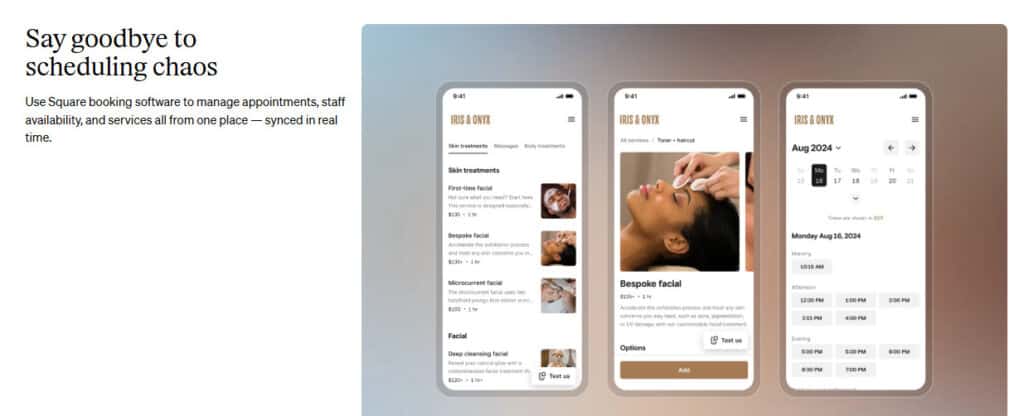
Trade-Offs
- Works best if your world already runs on Square.
- If you move off Square POS, the advantage disappears immediately.
My take: For restaurants and counter-service retail on Square, this is the cleanest way to go from register to paycheck.
4) ADP RUN: Scalable With Classic Payroll Depth
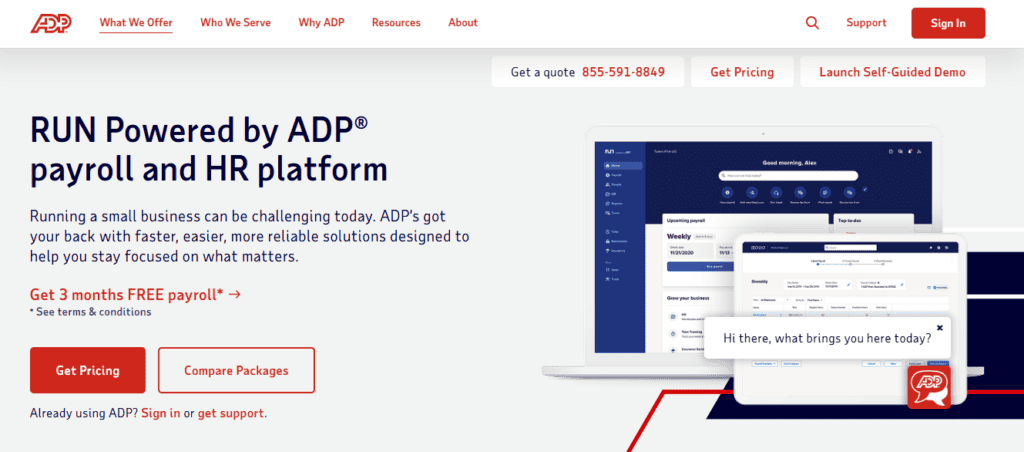
Why I Like It
RUN Powered by ADP is the small-business product in the ADP family. It’s battle-tested, with strong tax filing and a menu of add-ons. ADP offers job costing reports and an optional time and attendance suite that integrates with RUN. This modular approach lets you start with payroll and add tools as your needs mature.
Pricing
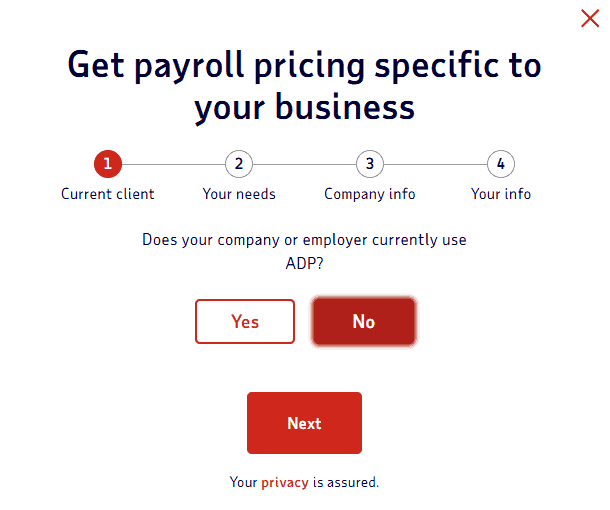
ADP quotes vary by package and promotions, which I absolutely despise. You’ll need to meet with a salesperson to find the true cost you’ll pay for the service, but expect it to be one of the higher ones on this list. Another key point for hourly teams: time and attendance is sold as an add-on for RUN. Plan for that in the budget.
Fit for hourly teams
- Robust payroll and compliance; wide add-on catalog (time, benefits, HR).
- Job costing and labor reporting help with project work.

Trade-Offs
- More moving parts and sales-driven pricing can slow setup.
- Interface and workflows feel heavier than SMB-first apps.
- Pricing is typically higher than others on this list.
My take: If you want “big-company” guardrails with room to grow, ADP RUN is a safe choice, just make sure to include the time/attendance add-on in your TCO.
5) Paychex Flex: Flexible Bundles with Strong Time Tools
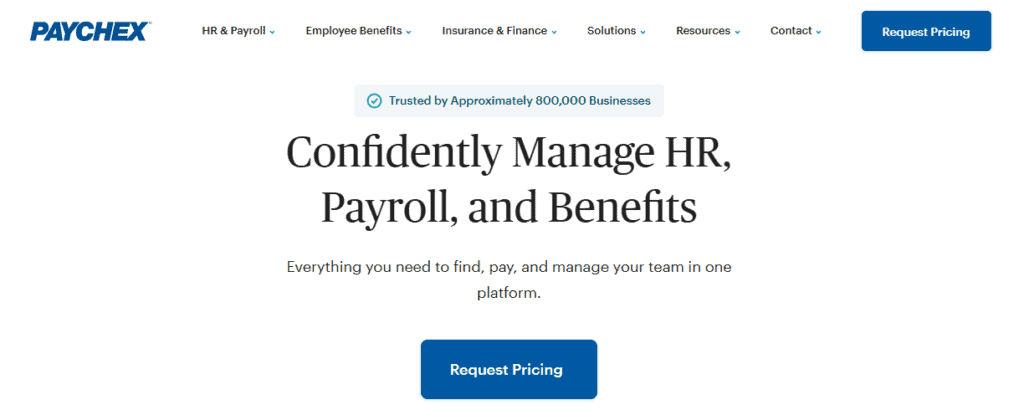
Why it stands out
Paychex Flex brings flexible payroll bundles and a well-developed time and attendance stack: it allows for mobile punches, kiosk and clock options (including biometric), and schedule management. That breadth serves mixed teams like office staff and hourly crews under one umbrella.
Pricing
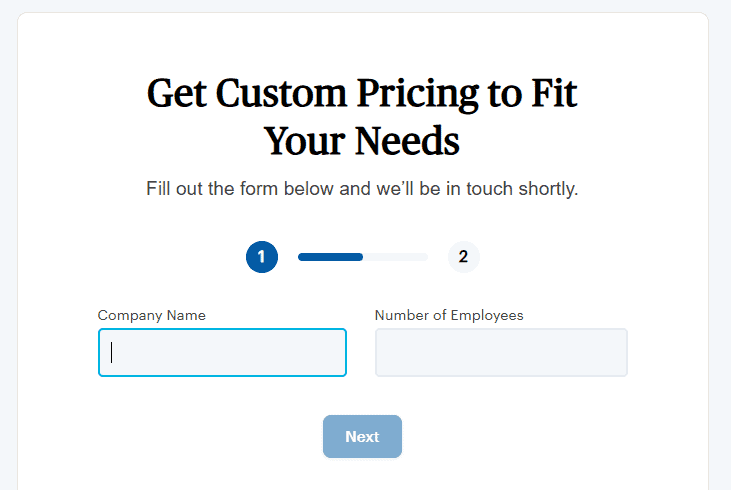
Paychex packages vary. Time and attendance is typically an add-on; some standalone time-off or time tools have minimums. Confirm current rates, minimums, and which features are in your tier. It’s similar to ADP in that to get a true cost, you’ll need to meet with a sales rep.
Fit For Hourly Teams
- Multiple punch options, manager approvals, and labor analytics.
- Integrates time/scheduling with payroll and HR. You can also utilize employee self-starting when onboarding to shift onboarding tasks to the employee instead of tying up management’s time.
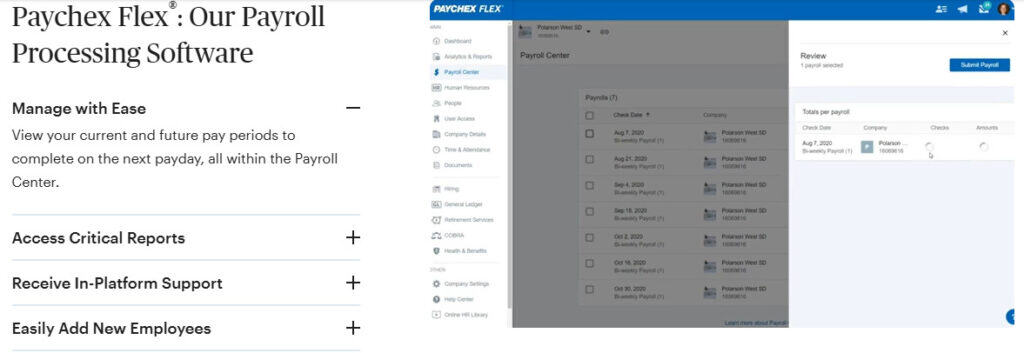
Trade-Offs
- Add-ons stack up; watch total cost.
- UI is improving, but not as light as newer SMB apps.
My take: Good for owners who want a single vendor for payroll, time, and HR, and who need hardware clocks or biometric options.
6) QuickBooks Payroll + QuickBooks Time: Best When Your Books Already Live in QuickBooks

Why I Like It
If your accounting sits in QuickBooks Online, pairing QuickBooks Payroll with QuickBooks Time (formerly TSheets) keeps hours, jobs, and paychecks close to the books. QuickBooks Time adds GPS, job codes, scheduling, and mobile approvals, then pushes hours to payroll. That reduces reconciliation work for the back office.
Pricing
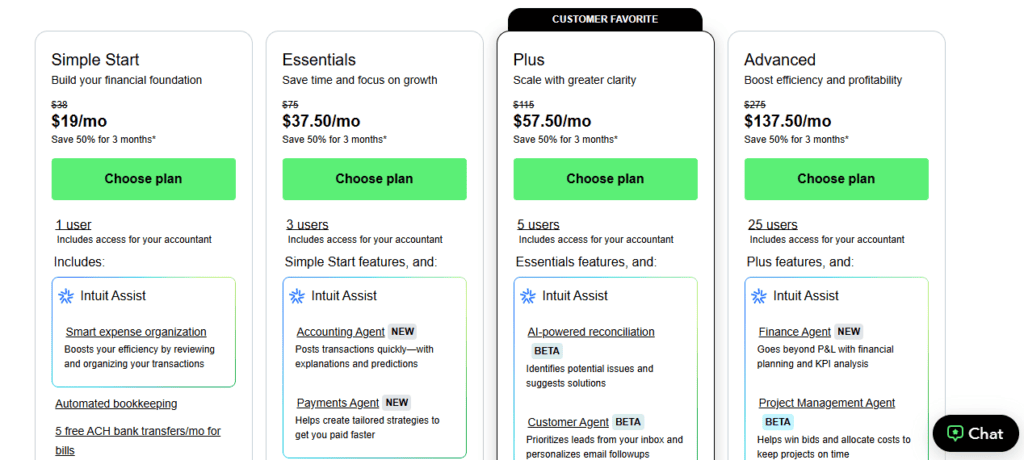
QuickBooks posts separate pricing for Payroll and for QuickBooks Time, however, let me tell you it won’t be cheap. Intuit is very proud of their products, and I have some clients with 40+ employees that are paying over $800 plus QB PR and the base software. Expect a base plus per-user for the time product (Premium or Elite tiers) on top of your payroll plan.
Fit for hourly teams
- Excellent if you already use QuickBooks for accounting.
- Time app supports mobile crews, scheduling, and job tracking.
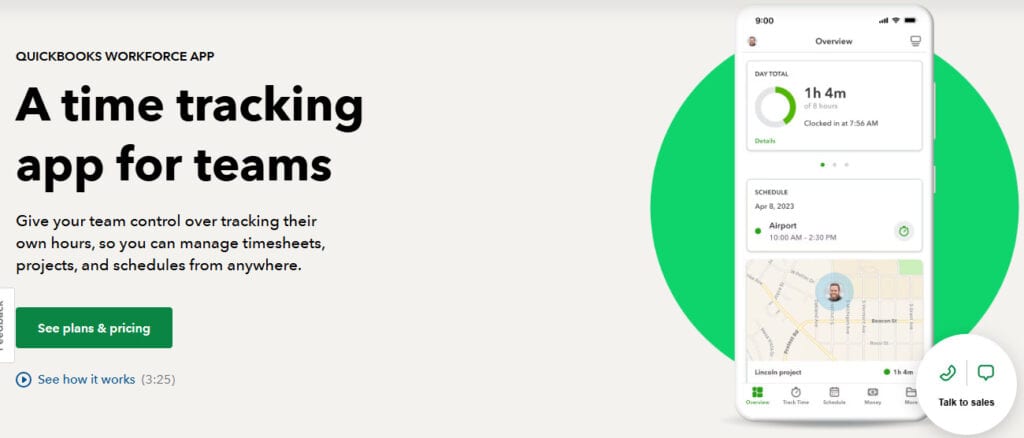
Trade-offs I notice
- Total costs to Intuit can become outlandish quickly.
- You’ll manage time and payroll modules rather than one all-in-one app.
My take: When your accounting is in QuickBooks and you want job tracking tied to the ledger, this pairing keeps everything aligned.
How I Would Choose (Real World Scenarios I’ve Been Through)
- Restaurant with pooled tips and shift swaps: I typically start with Homebase or Square Payroll, depending on the client’s discretion. If you’re not already on Square POS, Homebase gets the edge for its all-in-one scheduling, time, messaging, and payroll with Tip Manager. If you are on Square, the POS + Shifts + Payroll loop is hard to beat.
- Retail with lots of part-timers and a simple benefits setup: I’ve used Homebase and Gusto for these types of setups. Gusto’s HR and onboarding are smooth, but you’ll need to add scheduling elsewhere. Homebase gives you the schedule and time clocks in the same app you use for payroll.
- Construction crews that move between job sites and need job costing: ADP RUN with time/attendance add-on, QuickBooks Payroll + QuickBooks Time, or Homebase. If your accounting is in QuickBooks and you rely on job reports, the QuickBooks pairing keeps costs tied to projects. If you want classic payroll depth with lots of modules, ADP RUN works, but budget for the time add-on. Homebase can fit small crews that want scheduling, GPS time, and simple job tags without enterprise weight.
- Contractor-heavy teams: I usually recommend ADP or Paychex Flex for these situations as it can be used to keep costs down when issuing payments, as you don’t need all the expensive add-on modules. I still advise to check pricing before committing, though.
Implementation Checklist That I Walk Through With Clients
- Map your hour flow: Where do hours start (kiosk, mobile, POS)? Who approves? When?
- Get Rules in Place: Overtime thresholds, meal/rest breaks, rounding, and missed-punch handling is handled by who? What are the SOPs?
- Define roles and rates: Many hourly workers wear two hats. Set each rate.
- Tip policy: Decide tip pooling method, eligibility, and cash-tip reporting.
- Job codes/projects: Keep them simple; train managers to tag hours at the source.
- Cutoff discipline: Pick a weekly schedule for approvals and stick to it.
- Dry run: Run one test payroll with last week’s hours; fix mismatches before go-live.
- Manager playbook: One-page SOP for edits, swaps, missed punches, and escalations.
- Audit trail: Turn on change logs; review exceptions weekly.
- Month-end tie-out: Reconcile gross wages, tips, and taxes to the ledger.
This process is dull, but it’s what keeps you out of back pay and tax trouble.
Where Each Platform Wins
- Homebase wins for hourly simplicity. It has scheduling, time, messages, tips, and payroll together. That translates to less swivel-chair work for managers.
- Gusto wins for easy payroll + HR when scheduling is light or handled elsewhere.
- Square Payroll wins for Square POS shops that want tips and time tied to the register.
- ADP RUN wins for depth and classic compliance needs, with job costing options.
- Paychex Flex wins for hardware clocks and scheduling across mixed workforces, so long as you don’t mind paying for it.
- QuickBooks Payroll + Time wins if accounting and job costing must live right in QuickBooks.
Final Thoughts
Hourly payroll goes smoothly when hours are clean before you hit “Submit.” That is why I lean toward systems that capture, approve, and move time in one flow. For most hourly teams, Homebase is the easiest path to that outcome, thanks to its tight loop between scheduling, time clocks, tips, and payroll. But “best” is contextual.
If you live in Square, Square’s stack may be a better fit. If you need broader modules or hardware clocks, ADP RUN or Paychex Flex fit that shape. If job costing ties back to QuickBooks, QuickBooks Payroll with QuickBooks Time keeps your numbers aligned.
Pick the workflow that your managers will use without thinking. The right choice is the one that keeps hours accurate, paychecks on time, and your attention on the floor and not in the back office.

